|
|
Created/dedicated as per personal communication with Tim Loeffler, July 29, 2016; October 19, 2017
Updated as per James P. Tuttle's The Hawk Moths of North America, July 2016
Updated as per BAMONA, July 29, 2016
|
Whitley County and Surrounding Counties
in northeastern Indiana
Sphingidae
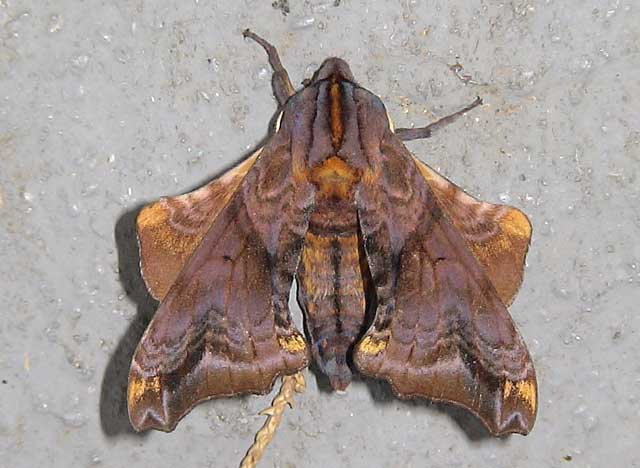
Paonias myops, Whitley County, Indiana,
July 13, 2008, courtesy of
Tim Loeffler.
This site has been created by Bill Oehlke.
Comments, suggestions and/or additional information/sightings are welcomed by Bill.
This page is inspired by and dedicated to Tim Loeffler of Whitley County, Indiana. Tim recently sent me a species list
for Saturniidae, Sphingidae and Catocala he has seen in Whitley County.
Although this page currently (October 19, 2017) references only data for Whitley County, it also serves as a checklist for the
surrounding counties in northeastern Indiana: Noble, De Kalb, Huntington, Wabash, Kosciusko, Elkhart, Lagrange, Steuben, Wells, Adams.
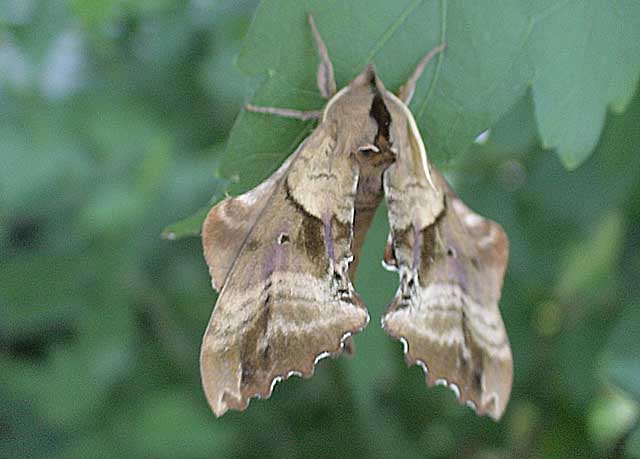
Paonias excaecata, Whitley County, Indiana,
July 17, 2008, courtesy of
Tim Loeffler.
Twenty-six Sphingidae species are listed for Indiana on the BAMONA website as of 2016.
Tim Loeffler reports the following from Whitley county, Indiana, 2017:
Amphion floridensis,
Sphecodina abbottii,
Manduca sexta,
Darapsa myron,
Amorpha juglandis,
Smerinthus jamaicensis,
Diedamia inscriptum,
Paonias myops,
Paonias excaecata,
Smerithus jamaicensis,
Eumorpha pandorus,
Pachysphinx modesta,
Hyles lineata,
Ceratomia amyntor,
Ceratomia undulosa
The only one I got last year and not this year is Darapsa choerilus.
Not all of the species are reported or anticipated in Whitley County (only one, Eumorpha pandorus is reported on BAMONA as of July 29, 2016. It is hoped
that this checklist, with the thumbnails and notes, will help you quickly identify the moths you are likely to encounter.
A "WO" after the species name indicates that I (William Oehlke) expect that this moth is present or
might be present. Most of the Sphingidae are very strong fliers. What can be found in Whitley County can also be found
in other northeasstern Indiana counties.
A "BAMONA" indicates the moth is reported on the BAMONA website and/or in Lepidoptera of North America, #1. Distribution of Silkmoths
(Saturniidae) and Hawkmoths (Sphingidae) of Eastern North America, an excellent little booklet available through Paul Opler.
Please help me develop this list with improved, documented accuracy by sending sightings (species, date, location), preferably with an
electronic image, via email to Bill Oehlke.
Visit Whitley County Sphingidae Larvae: Caterpillars; Hornworms
Visit Indiana Catocala: Underwing Moths
If you are travelling, you can find active Sphingidae checklists for all countries in North, Central, and South America and the Caribbbean via the links at
North, Central, South American Sphingidae checklists
Sphinginae subfamily
Sphingini tribe:
 |
Agrius cingulata, WO Pink-spotted hawkmoth, stray.
This moth is a very strong flier, but would only make its way to Whitley County as a rare stray, possibly late summer or early fall. |
 |
Ceratomia amyntor Tim, Elm Sphinx; Four-horned Sphinx.
The upperside of the forewing is brown with dark brown and white markings including a white costal area near the wing base,
dark streaks along the veins, and a white spot in the cell. The upperside of the hindwing is light brown and has a dark brown band along the outer margin.
|
 |
Ceratomia catalpae WO, Catalpa Sphinx.
The upperside of the forewing is yellowish brown with no white markings, but there are indistinct black lines
and dashes. The cell spot is gray with a black outline and the upperside of the hindwing is yellowish brown with obscure lines. |
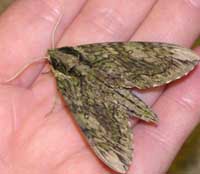 |
Ceratomia hageni WO, Hagen's Sphinx or Osage Orange Sphinx.
The upperside of the forewing is gray with a green tint and has dark indistinct wavy lines, and pale gray patches at the wing tip and along the costa. The upperside
of the hindwing is dark grayish brown with paler gray at the base and outer margin. |
 |
Ceratomia undulosa Tim, Waved Sphinx.
Usually pale brownish gray (occasionally dark) with wavy black and white lines and a black-outlined white cell spot. The upperside of the
hindwing is gray with diffuse darker bands. |
 |
Dolba hyloeus WO, Pawpaw Sphinx.
The upperside of the forewing is dark brown with a dusting of white scales. Some moths have patches of reddish or yellowish brown on the wings. |
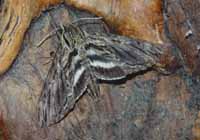 |
Lintneria eremitus Tim, Hermit Sphinx.
The upperside of the forewing is gray-brown with wavy lines, black dashes, and one or two small white spots near
the center of the costa. The upperside of the hindwing is black with two white bands and a triangular black patch at the base. Note the golden hair on the thorax.
|
Lintneria eremitus, July 27, 2016, Tim Loeffler.
 |
Manduca quinquemaculatus WO, Five-spotted Hawkmoth.
The moth abdomen usually has five but sometimes six pairs of yellow bands. The upperside of the forewing is blurry brown and gray. |
 |
Manduca sexta Tim, Carolina Sphinx.
The abdomen usually has six pairs of yellow bands, broken across the back. The sixth set of markings is quite small.
The upperside of the forewing has indistinct black, brown, and white markings. Larvae get very large and can strip a tomato plant. |
 |
Paratrea plebeja WO, Plebeian Sphinx. The upperside of the forewing is gray with indistinct black and
white markings. There is a series of black dashes from the base to the tip, and a small white cell spot. |

|
Sphinx canadensis
WO,
Sphinx canadensis, the Canadian Sphinx:
The absence of the white spot on each forewing and the more brownish coloration serve to separate canadensis from S. poecilus.
The hindwing fringe also tends to be white on poecilus and checkered brownish on canadensis.
|
 |
Sphinx chersis WO,
the Northern Ash Sphinx or Great Ash Sphinx:
The upperside of the forewing is soft dark gray to blue-gray with a series of black dashes, one of which reaches the wing tip.
The upperside of the hindwing is black with blurry pale gray bands.
|
 |
The forewing costa and terminal areas are pale grey while the rest of the wing is a dark slate grey.
|
 |
Colouration and markings are highly variable from one specimen to another.
The fringes on forewing are mostly black with some white; those on
the hindwing are mostly white with a few black patches.
|
 |
The lower forewings are predominantly brownish-yellow with a fairly wide dark bar along the inner margin.
At rest the wings hug the body, giving the moth a long slender look.
|
Smerinthini Tribe:
 |
The adults are highly variable; sometimes wings of an individual may be all one color or may have several colors,
ranging from pale to dark brown, and may have a white or pink tinge. Patterns range from faint to pronounced.
|
 |
Pachysphinx modesta WO/Tim, 2017, the Modest Sphinx or Poplar Sphinx.
Larvae are fond of poplars and willows.
|
 |
Named for the dull grey-blue spot (minus dark pupil) in the hindwing,
this moth has a wide distribution and is probably common in Allen
County.
I regularly see them on Prince Edward Island, and they are reported
as far south as Florida.
|
Paonias excaecata, July 17, 2008, Tim Loeffler
 |
Paonias myops
Tim, the Small-eyed Sphinx
Named for the small eye-spot in the hindwing, this moth has a wide distribution
and is probably common in Whitley County.
I regularly see them on Prince Edward Island, and they are reported
as far south as Florida.
|
Paonias myops, July 13, 2008, Tim Loeffler
 |
Smerinthus cerisyi
WO, the Cerisyi's
Sphinx or One-eyed Sphinx, Larvae feed on poplars and willows.
Flight would be from late May-July as a single brood.
Questionable, generally more northerly species
|
 |
Smerinthus jamaicensis
WO/Tim, 2017,
the Twin-spotted Sphinx.
This moth is widely distributed and fairly common.
Along the East Coast, it flies from P.E.I. to Florida, with many reports from Kentucky and Michigan.
|
Macroglossinae subfamily
Dilophonotini tribe:
See Hemaris comparison
to help distinguish the next three species.
 |
Hemaris diffinis
WO,
Snowberry Clearwing or Bumblebee Moth:
Hemaris diffinis is a very variable species, but almost always the abdomen sports contrasting black and yellow hairs, the ventral surface being quite black. The
legs also tend to be quite dark and
there is a black mask running across the eye and along the sides of the thorax.
|
 |
Hemaris gracilis
WO, the
Slender Clearwing or Graceful Clearwing:
Hemaris gracilis is distinguished from similar species by a pair of
red-brown bands on the undersides of the thorax, which varies from
green to yellow-green dorsally and sometimes brown with white
underneath. The upper surfaces of abdomen and legs tend to be red.
|
 |
Hemaris thysbe
Tim, the Hummingbird Clearwing
It is not difficult to see why many gardeners would mistake an Hemaris thysbe moth for a small hummingbird as it hovers,
sipping nectar from flowers through a long feeding tube.
|
Philampelini tribe:
 |
Eumorpha achemon WO, Achemon Sphinx.
This moth is not officially reported for Allen County, but
has been reported to north, east, south and west.
Note the differences between this moth and the Pandorus Sphinx.
|
 |
Eumorpha pandorus Tim, Pandorus Sphinx.
If you have Grape or Virginia Creeper nearby, then you probably have
this species.
I often get reports of larvae from outside the reported range.
|
Macroglossini tribe:
 |
Amphion floridensis Tim, Nessus Sphinix.
This day flier is widely distributed. If you have Virginia Creeper, you probably have the Nessus Sphinx.
Two bright, distinct, narrow yellow bands are often visible on the abdomen. |
 |
Darapsa choerilus Tim, Azalea Sphinx. They are common in New Jersey and common
here on Prince Edward Island, and they are probably common in Whitley Co..
You will often see this species listed as Darapsa pholus, especially in older literature. |
Darapsa choerilus, July 29, 2016, Tim Loeffler.
 |
Darapsa myron Tim, Virginia Creeper Sphinx; Grapevine Sphinx.
The forewing upperside is dark brown to pale yellowish gray, with an olive to definite green tint.
On the costal margin there is a dark rectangular patch, although this may be reduced or absent. The upperside of the hindwing is pale orange. |
 |
Darapsa versicolor WO, Hydrangea Sphinx.
The forewing upperside is often greenish brown with curved dark lines and pinkish-white patches.
The hindwing upperside is pale yellow to reddish brown with white along the costal margin, greenish brown along the outer margin, and white shaded with greenish
brown on the inner margin. |
 |
Deidamia inscriptum Tim, Lettered Sphinx.
The moth's outer margin of the forewing is deeply scalloped. The upperside is light brown with dark brown markings.
There is a small black and white spot near the tip. The upperside of the hindwing is orange-brown with a dark brown outer margin and median line. |
 |
Hyles lineata WO/TL, the White-lined Sphinx.
This species has strong migrating tendancies from much further south. There are records from New Hampshire, Maine, Michigan, Illinois, etc. |
Hyles lineata, September 2 and September 21, 2017, Tim Loeffler
 |
Sphecodina abbottii Tim, Abbott's Sphinx.
This moth is very much under reported across the United States. It is a rapid day flier so is probably not in too many collections.
Grape is a popular larval host. |
|
|
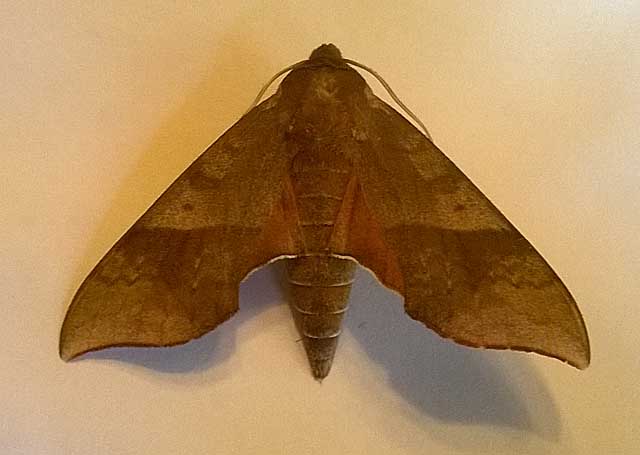
Darapsa choerilus, Whitley County, Indiana,
July 29, 2016, courtesy of Tim Loeffler
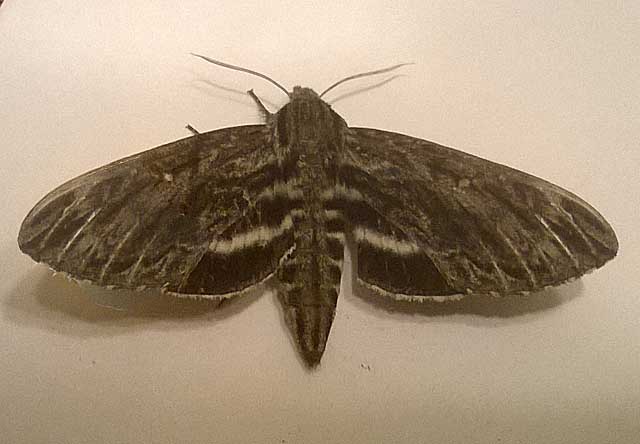
Lintneria eremitus, Whitley County, Indiana,
July 27, 2016, courtesy of Tim Loeffler
Enjoy some of nature's wonderments, giant silk moth cocoons.
These cocoons are for sale winter and fall. Beautiful Saturniidae moths will emerge the following spring and summer.
Read Actias luna rearing article.
Additional online help available. Eggs of many North American species are offered during the spring and summer. Occasionally
summer Actias luna and summer Antheraea polyphemus cocoons are available. Shipping to US destinations is done
from with in the US.
Use your browser "Back" button to return to the previous page.
This page is brought to you by Bill Oehlke and the
WLSS. Pages are on space rented from Bizland. If you would like to become a "Patron of the Sphingidae Site", contact Bill.
Please send sightings/images to Bill. I will do my best to respond to requests for identification help.
 | 
Show appreciation for this site by clicking on flashing butterfly to the left.
The link will take you to a page with links to many insect sites. |
This website has been created and is maintained by Bill Oehlke without government or institutional financial assistance. All expenses, ie., text reference
support material, webspace rental from Bizland, computer repairs/replacements, backups systems, software for image adjustments (Adobe Photoshop; L-View),
ftp software, anti-virus protection, scanner, etc. are my own.
I very much appreciate all the many images that have been sent to me, or of which I have been granted permission to copy and post from other websites.
All images on this site remain the property of respective photographers.
If you would like to contribute to the maintenace of this website by sending a contribution to
Bill Oehlke
Box 476
155 Peardon Road
Montague, Prince Edward Island, C0A1R0
Canada
your donation would be much appreciated and would be used for
1) paying for webspace rental;
2) paying for computer maintenance and software upgrades;
3) purchases of additional text reference material (journals and books) in anticipation of expanding the site to a worldwide Sphingidae site;
4) helping to pay my daughter's tuition (completed spring 2013); with anything left over going to humanitarian aid.
If you are mailing a check from USA, please use $1.10 postage (2013 rate). In 2014 the opostal rate from US to Canada is $1.15 so check with
post office first, as postage rates seem to be increasing almost annually ($1.25 is 2017 rate). Donations can also be made through Paypal via the button
below.





